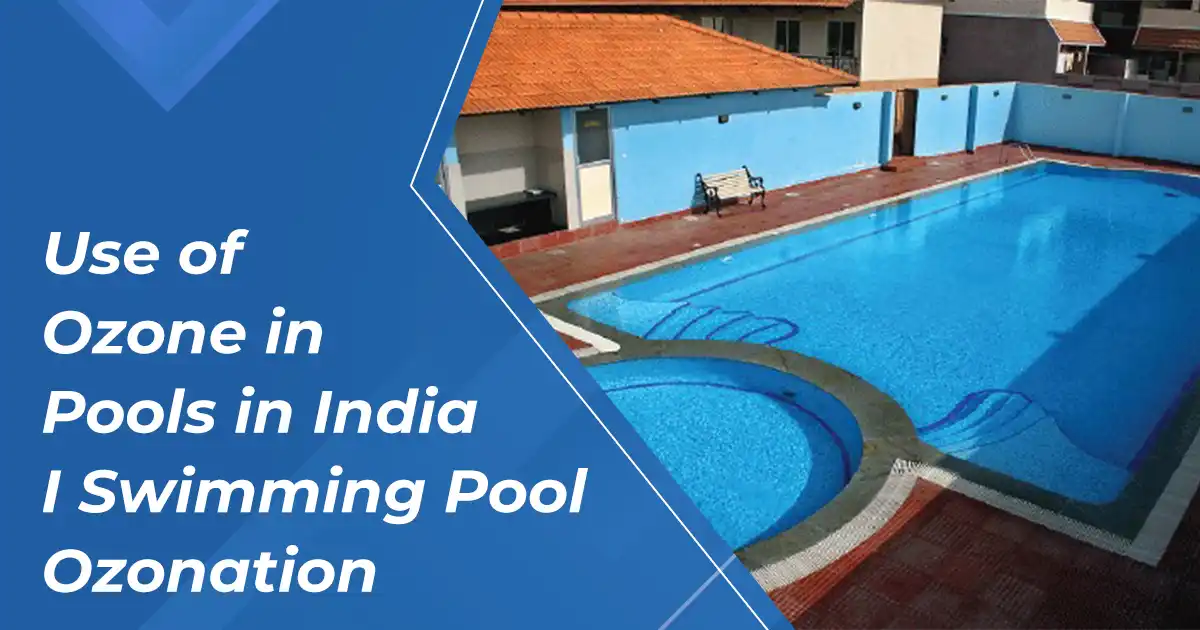Swimming Pool Ozonation


With the advent of isocyanuric crystals, commonly known as crystal chlorine, there are increasing incidences of cloudiness of pools and increased chlorine smell . The chlorine crystals are heavily loaded into the pool that results in increased formation of chloramines and hence the smell
Before we go deeper into this problem let us understand a few basic reactions of chlorine .
Chlorine when dissolved in water forms two reaction compounds.
(1) Cl2 + H2O →HCl + HOCl
The HCl is hydrochloric acid, which acts to lower the pH of the water.
The other compound is hypochloric acid, and it is what we call chlorine.
The HOCl is the active disinfectant in the water. It can be generated by adding chlorine gas; sodium, calcium hypochlorite, or isocyanuric acid Chlorine itself does not smell .The bleach you buy home smells but this is a highly concentrated product. When this is diluted you can hardly get the small
Than what is this chlorine small in pools? the odor associated with indoor swimming pools, the pool chlorine odor?
The contaminants in a swimming pool can be classified into organic, inorganic and microbiological. Chlorine is a good sanitizer and oxidiser, but these processes create unpleasant and unhealthy by-products. When chlorine oxidises organic contaminants (body wastes, soaps, cosmetics etc) carcinogenic chlorinated organics (THMs) are produced in abundance
 Chlorination of nitrogenous body wastes result in Chloramines which cause an unpleasant smell and are the source of stinging eyes, ear and skin irritation.
Chlorination of nitrogenous body wastes result in Chloramines which cause an unpleasant smell and are the source of stinging eyes, ear and skin irritation.
How do we get rid of this odour?
To get rid of this odour of combined chlorine, pool operators will do a breakpoint or super chlorination. This means adding sufficient amounts of chlorine so that the chloramines are destroyed. Because the reaction is very slow, it is usually performed overnight, meaning the operator needs to stay after the pool closes, and come back early next morning to de chlorinate, if necessary.
This is where ozonation of swimming pool water wins the admiration of the operators. Because ozone is much more effective than chlorine in the oxidation of chloramines, a properly designed ozonation system will get rid of the chloramines, even though the contact time for a typical ozone system is only a few minutes, compared to the hours of overnight breakpoint chlorination. From the operator’s point of view, this might be the best feature of swimming pool ozonators – no more late night and early morning hours, even in extremely heavily loaded pools.
Cloudy Pools:
Another undesirable feature of poorly operated pools is cloudy water. It will be as though you have poured milk into the pool .The problem is that there are many different reasons for cloudy water in pools, and to find the correct reasons for the cloudiness requires some knowledge of both equipment and chemistry.
Pool owners like hard water. It prevents leaching of calcium from plaster, grout or concrete. The recommended calcium levels are 80 –160 mg/L as Ca 2+ , or 200 – 400 mg/L when expressed as calcium carbonate (CaCO3). Even higher levels are fine. This is quite different from drinking water, where 150 mg/L (as CaCO3) is already considered hard.
Now that the dissolved.CO2 is normally used as a buffer (alkalinity) – we have a combination ripe to lead to calcium precipitation. All an operator needs to do is to let the pH climb above 8.3. Calcium carbonate falls out, and neither lowering the pH to the usually mandated level of 7.2 – 7.8 nor ozone will get rid of the precipitate.
There are other possibilities for cloudy water. Long turnover times and a poorly maintained or undersized filtration system can lead to cloudy water. Very often the pool maintenance guy is blamed .What could be the main cause of this problem is badly designed pool filtration system Again, under those circumstances; ozonation will not be a solution for removing the turbidity.
The most common cause for cloudy pool water is insufficient oxidation. It might surprise you to hear that up to 90% of the chlorine used in a pool is not consumed as the active sanitizer, but as an oxidant. The chloramine formation described above is a case in point. Rather than having too much chlorine, these pool don’t have enough.
Ozone, as the most powerful oxidant in all of water treatment .Whenever the pool owner complains of odors, red eyes and itching, retrofitting the pool with an ozone system will almost resolve the problem overnight!
What is required here is a properly sized Ozonation system. Pools having installed small systems, find that they either don’t work at all, or make little difference.
Why Ozone is the preferred solution for safe pools?
Ozone prevents the formation of scum line forming; filter clogging chlorinated organics and eye, skin irritating; hair and swimsuit discolouring chloramines. Upon completion of these significant oxidation tasks, Ozone reverts to Oxygen, leaving no by-products behind.
To date ozone water treatment is the best solution available, yielding the most modern, safest and most environmentally friendly sanitation of pools and SPAs.
Effects of Ozone treatment

Safe for lungs

Safe for Hair

Safe for Eyes
No burning of eyes

Safe for Skin
No peeling
or scaling of skin

Safe for Ears
No irritation or
fungal infection

Safe for Children
No diarrhoeas

Safe for Environment
Saves 70% chemicals
and 50% water


